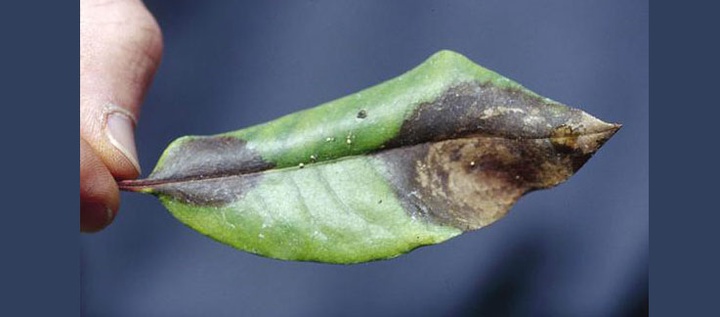Jessica Cejnar / Friday, Sept. 27, 2019 @ 2:55 p.m. / Environment, Science, Wildlife
UC Berkeley, Cooperative Extension, CalFire Scientists Say They Found Sudden Oak Death At Jed Smith, Discovery Not Confirmed

UC Berkeley, UC Cooperative Extension and CalFire scientists say they may have discovered sudden oak death at Jedediah Smith Redwoods State Park this summer. Photo: Courtesy of USDA Animal and Plant Health Inspection Service
Scientists with the University of California, Berkeley, and CalFire say they discovered signs of sudden oak death this summer at Jedediah Smith Redwoods State Park.
If confirmed, it will be the first time that sudden oak death has shown itself in a new California county since 2014, Berkeley News reported on Tuesday. But samples sent to the California Department of Food and Agriculture’s Plant Pathology Lab for testing have yet to come back to Del Norte County, Agriculture Commissioner Justin Riggs told the Wild Rivers Outpost on Thursday. Those samples must test positive in order for the county to take official action, he said.
Brett Silver, acting sector superintendent for the California Department of Parks and Recreation, said he was unaware of the discovery of sudden oak death at Jedediah Smith this summer. The county department of agriculture would notify them if a finding has been confirmed. Silver said his department hasn’t received that notification.
“Typically if anyone’s doing research in the parks they have to get a research permit from the park and what results came up back to the parks so they can stay on top of issues,” Silver said. “We don’t have anything from Berkeley on sudden oak death studies.”
California Oak Mortality Task Force Chair Chris Lee, of CalFire, said he found a dead tan oak along Howland Hill Road in July during this year’s SOD Blitz, an annual survey led by CalFire, Berkeley and the UC Cooperative Extension program. Lee said the team of scientists taking part in the survey revisited the site earlier this month and found a second dead tan oak.
“Two have died and there were a few symptoms on some of the tan oak leaves,” Lee said. “There aren’t really any other obvious symptoms or obvious dead trees around so we do suspect that the pathogen is in a really really early stage of establishment right now.”
The pathogen, Phytophthora ramorum, is a fungus-like water mold that has ravaged oaks and tanoaks in California since it was first discovered in the United States in the late 1980s, Berkeley News reported.
In California the disease spreads by two host trees, Lee said. The California bay laurel, or pepperwood, is the main driver, but other than infecting the tree’s leaves, the pathogen doesn’t do them much harm, he said.
In tan oaks, sudden oak death will attack the main trunk and kill the tree, Lee said. It also infects twigs, producing spores that spread the infestation. Once a tan oak is infected, it can take three to four years before it dies, Lee said.
“On both bay laurel and tan oak trees, when lots of spores are produced in the wintertime, they’ll blow and splash around to other trees and they’ll begin infections,” Lee said. “It’s hard to know exactly how long the pathogen may have been present, causing infections.”
There are two sudden oak death strains, Lee said. The diseased tan oak trees found at Jedediah Smith are infected with the North American strain, which is less aggressive than the European strain, he said.
Scientists with UC Berkeley, the UC Cooperative Extension and CalFire have been monitoring Del Norte County waterways for sudden oak death since about 2004, Lee said. The SOD Blitz also conducts surveys in areas that visitors frequent heavily, including day-use areas and campgrounds.
This year, Lee said, scientists with the SOD Blitz decided to travel major roads in Del Norte, including Howland Hill Road.
According to Lee, if the California Department of Food and Agriculture confirms that the dead tan oaks in Jedediah Smith were infected by sudden oak death, there is a complicated process for how that will affect the movement of plant materials into and out of Del Norte County.
In addition to the state, the U.S. Department of Agriculture lab in Maryland must also confirm that the trees are infected with sudden oak death, Lee said.
“As far as management, it depends on who the landowner is and what the landowners want to do to try to contain the pathogen or not try to contain the pathogen,” he said. “There has been various efforts over the years in California on an experimental basis with varying levels of success. In Oregon, they have a very long -running sustained effort that the state has undertaken to try to slow the spread of the pathogen.”
Lee said more information on whether sudden oak death is in Del Norte County and how extensive the infestation is would be necessary before deciding how to handle it. The U.S. Forest Service has addressed another disease that’s closely related, Port Orford cedar root disease, by controlling access to areas with valuable natural resources, he said.
According to Silver, however, Oregon has tried to manage the spread of sudden oak death without much success. Since the disease doesn’t show itself in host species for up to three years, it can spread to other locations sometimes up to 2 kilometers away, he said.
Attempts to control the spread of sudden oak death include asking hikers to spray bleach on their shoes, closing access roads during the winter and cutting back buffer zones, Silver said.
However, tan oaks are the only trees vulnerable to sudden oak death, he said.
“If you’re looking at a positive, it doesn’t kill any other species of trees,” Silver said. “It’s not ideal, but it could be much worse. If this was affecting every tree in a forest, that would be critical.”
CLICK TO MANAGE